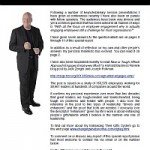 This is the second in a series of posts exploring 10 keys to getting high performing teams. This one looks at the second key: getting crystal clarity on responsibilities and what is expected.
This is the second in a series of posts exploring 10 keys to getting high performing teams. This one looks at the second key: getting crystal clarity on responsibilities and what is expected.
I’m a keen amateur photographer and I recently got a new camera which came with a 200 page manual. Did I read it before using the camera? No! Fortunately it came with a shorter “quick start” guide with enough information to get me going, and as I got more proficient I have referred to the manual when I needed answers to specific questions. I have also learned from video tutorials on the internet, as well as learning from other users of this camera via online forums.
For most of us, learning a new job is a lot more involved than learning how to use a camera. How do we go about that task? What support is given? Are we given a “quick start” guide as well as a fuller manual? Different people have different learning styles and preferences. What provision is made for these differences?
Many workplaces still operate on models first developed for the industrial age, when factory workers were basically cheap machines doing simple and repetitive tasks. What mattered was standardisation and rate of output, and so we have written job descriptions (standardisation) and Key Performance Indicators (KPIs) expressed as output in a given time. At its most primitive, the induction process for a new worker consisted of telling them their job description and KPIs, giving them the Policies and Procedures manual to read and showing them where the toilets are.
The problem with this is that human beings are not machines. We not very motivated to blindly obey. We more are motivated by relationships and tasks that have meaning for us. Furthermore, the nature of work today is much more fluid and flexible than in the past and is often better described as a series of projects than as a single unchanging role.
30 years ago in The One Minute Manager Ken Blanchard and Spencer Johnson outlined a beautifully elegant solution which is still relevant. The work is described as a series of goals, each of which is discussed and agreed upon between the employee and their manager. The goal and its performance standard is then expressed in not more than 250 words. The important thing here is the conversation, in which questions are asked and any objections raised until there is sufficient clarity to write those 250 words. The reason for keeping it short is that it should be able to be read in a minute or less so that it can be referred to frequently. Blanchard and Johnson suggest following the 80/20 rule and just focusing on the 20% of goals which lead to 80% of the results. For each additional project that arises, the same procedure is followed.
Much of this thinking is adopted, refined and developed further in the Enhancing Their Gifts System by Ian Berry (for which I’m an accredited mentor). Rather like the idea of the One Page Business Plan, individual employees need their own one-page Personal Performance Plan. The important points to remember are:
- Clarity comes through open and honest conversations rather than from reading job descriptions and policy manuals.
- Getting to crystal clarity takes time. It may take two or three cycles of goal-setting conversations -> do the work -> review progress -> have a further goal-setting conversation.
Daniel Pink, in his book Drive: The Surprising Truth About What Motivates Us talks about the drive towards mastery which is part of human nature. Once we set ourselves a goal, we are driven to achieve it and we keep trying until we master it. But once we have mastered it we lose interest until the next challenge comes along.
And in his work on Flow, psychologist Mihaly Csikszentmihalyi found that we are most deeply engaged and satisfied when we are doing something which is on the edge of our competence: i.e. not so hard that we get frustrated and give up, but not so easy that we get bored.
This is another reason why static job descriptions will not get the best out of people. As humans, we need to keep growing and stretching ourselves. This must be reflected in our goals which should be reviewed and adjusted every 3-4 months.
There is much more to it than this, and some will be covered in future posts, including the next in this series which talks about aligning personal and organizational goals.
One last thing to cover in this post concerns getting clear on relationships and responsibilities. Western culture (especially Anglo-Saxon culture) emphasizes individualism and individual responsibilities. However highly effective teams take equally seriously the collective team responsibilities. It is the recognition that each of us depends on the others in our team if we are to succeed in our goals, and that being successful in our goals enables others and the team to succeed in their goals.
With that in mind, it is also important for employees to understand the goals, expectations and accountabilities of the other people in their team. As social animals we are hard-wired to map the social structures we are a part of. It is part of our sense-making nature to want to understand how we fit into the overall community and we will not be able to relax and perform at our best until we do.
Again, getting this clarity will not be instantaneous, but a successful organisation will give regular opportunities for new team members to get to know the rest of the team and their roles, and will support then through this learning process.
Much of this is just plain common sense. Yet it is surprising how many organisations fail to maximise their investment in people. Some figures from the USA indicate that half of all hourly workers quit within the first 120 days and 50% of all senior staff hired from outside the organization will fail within the first 18 months [i].
It is the equivalent of buying an expensive camera and then using it on “auto” without reading the instructions. If you are lucky then you will get some passable results (but nowhere near what you’d get if you learned how to fully use it) and if you are unlucky you will break it and need to buy another one.
Mike Lowe
Helping individuals and teams get into flow
[i] Cited in http://www.hcamag.com/opinion/best-practices-for-new-employee-onboarding-176865.aspx





